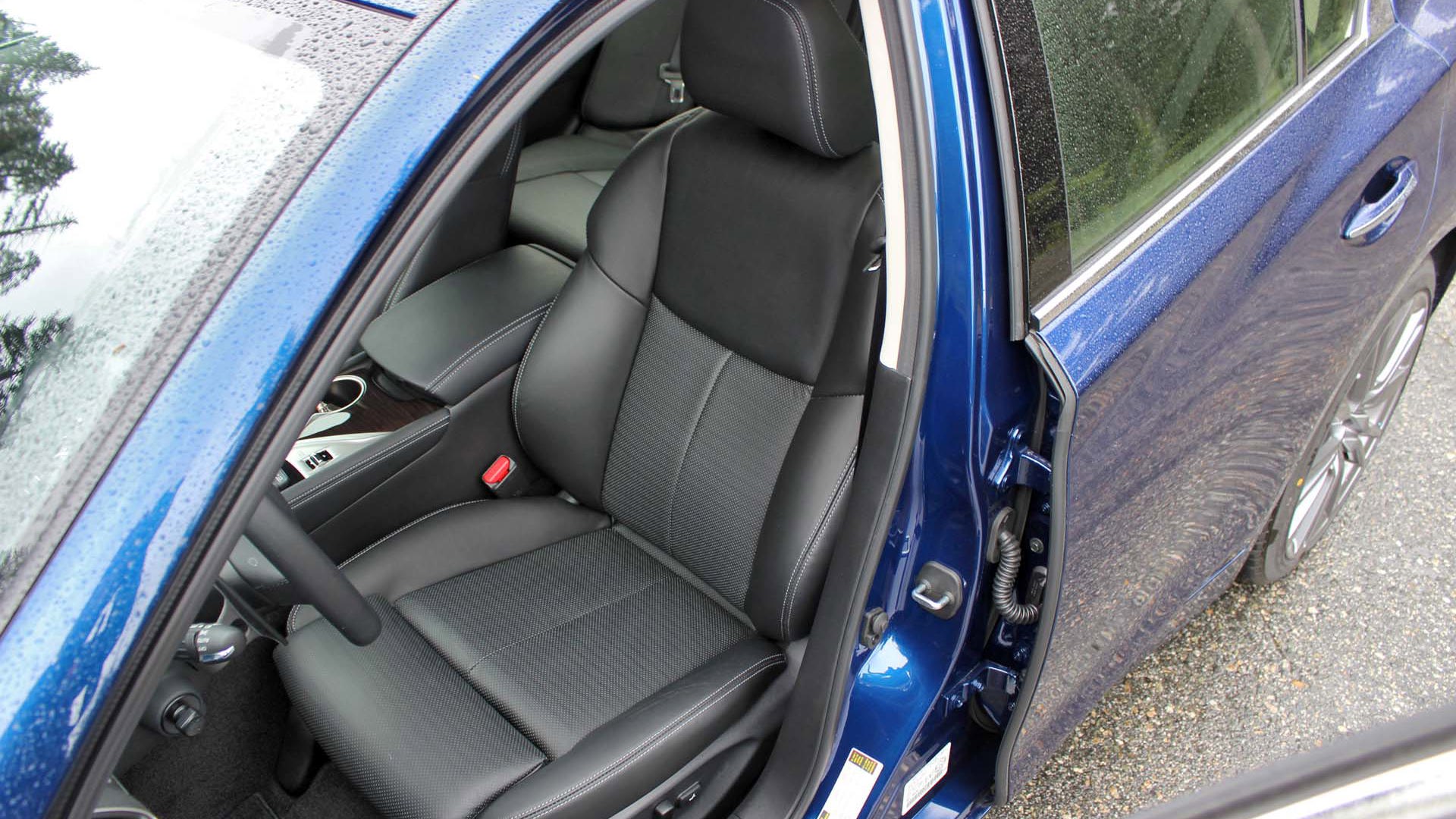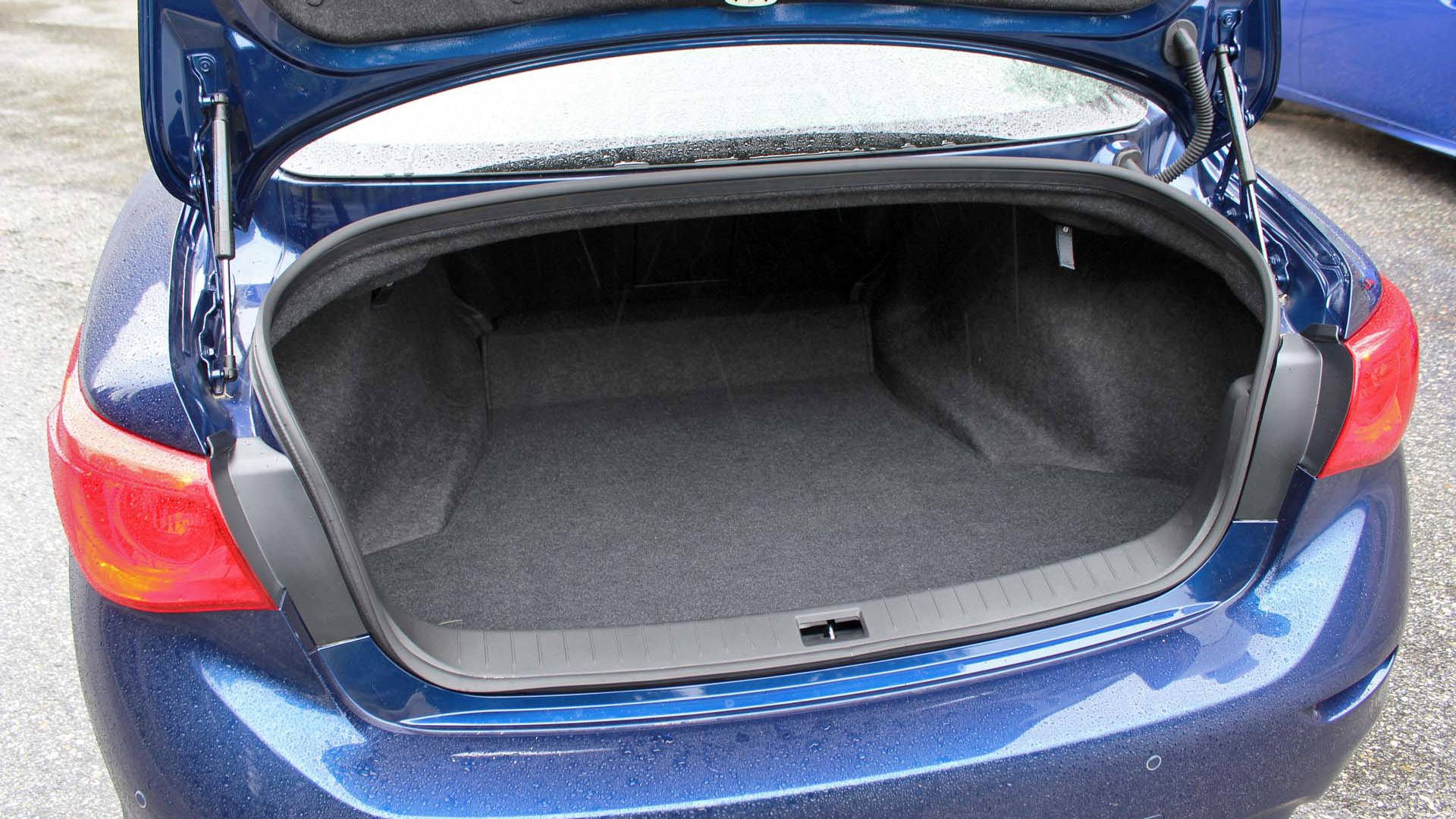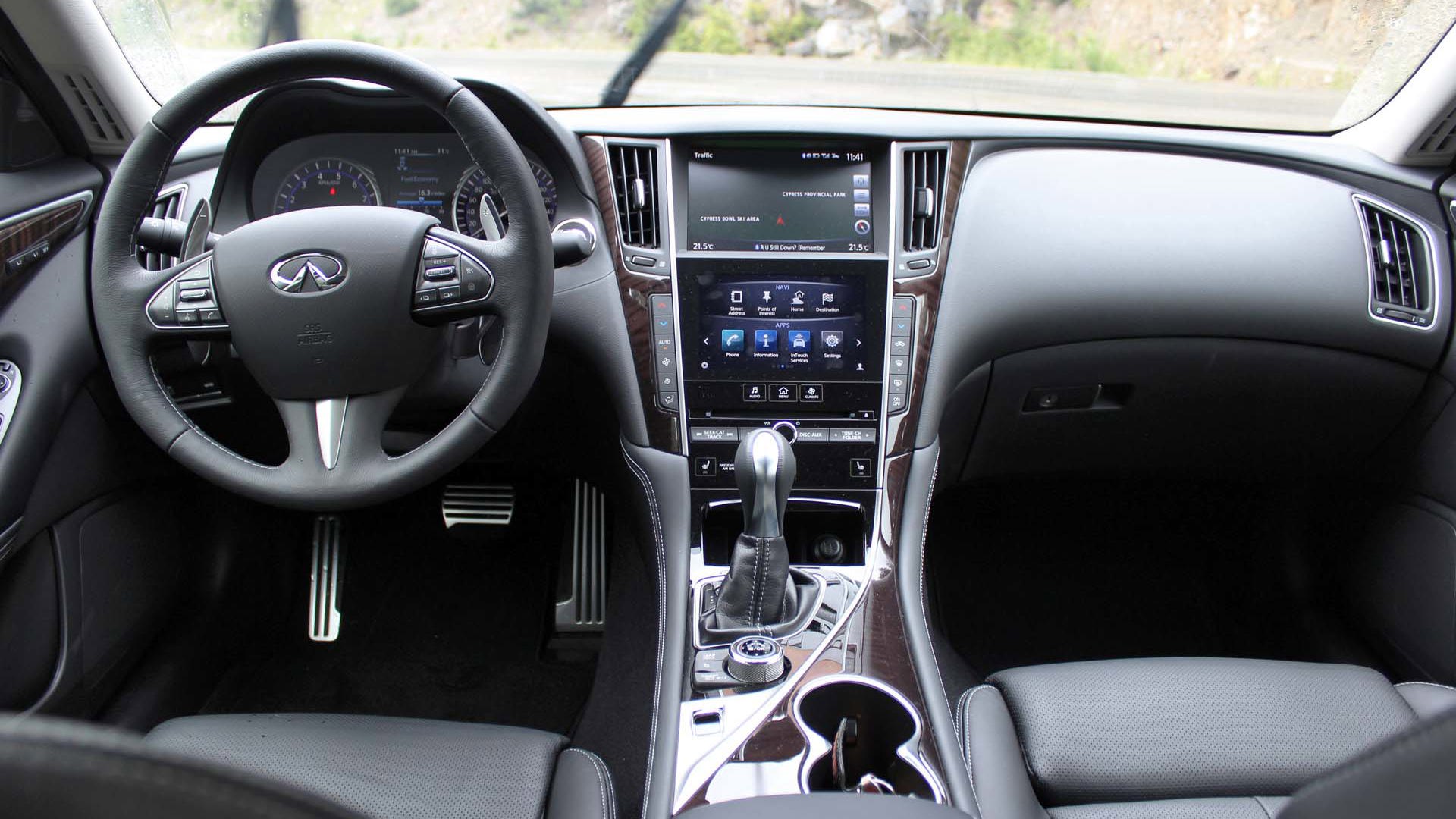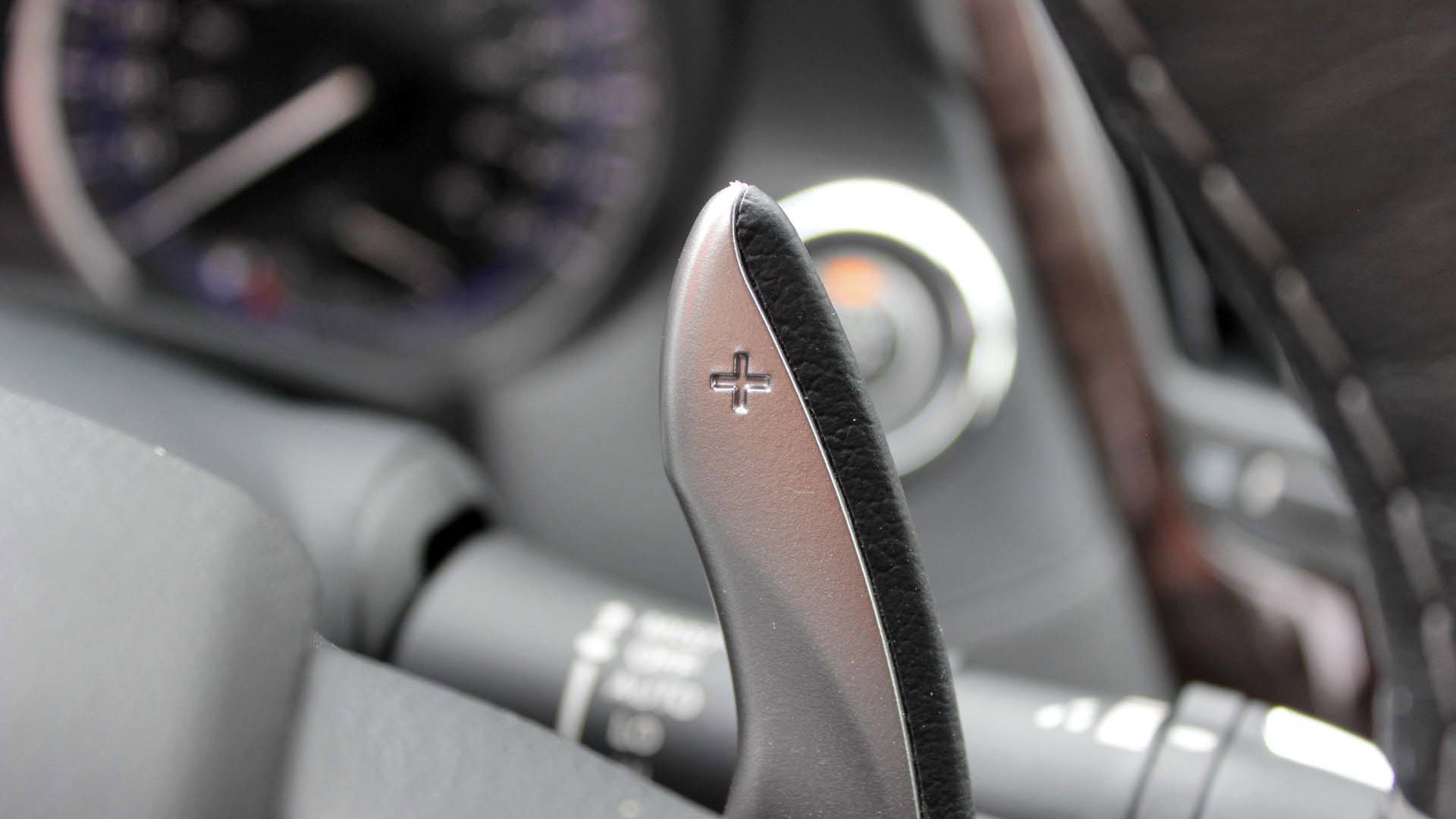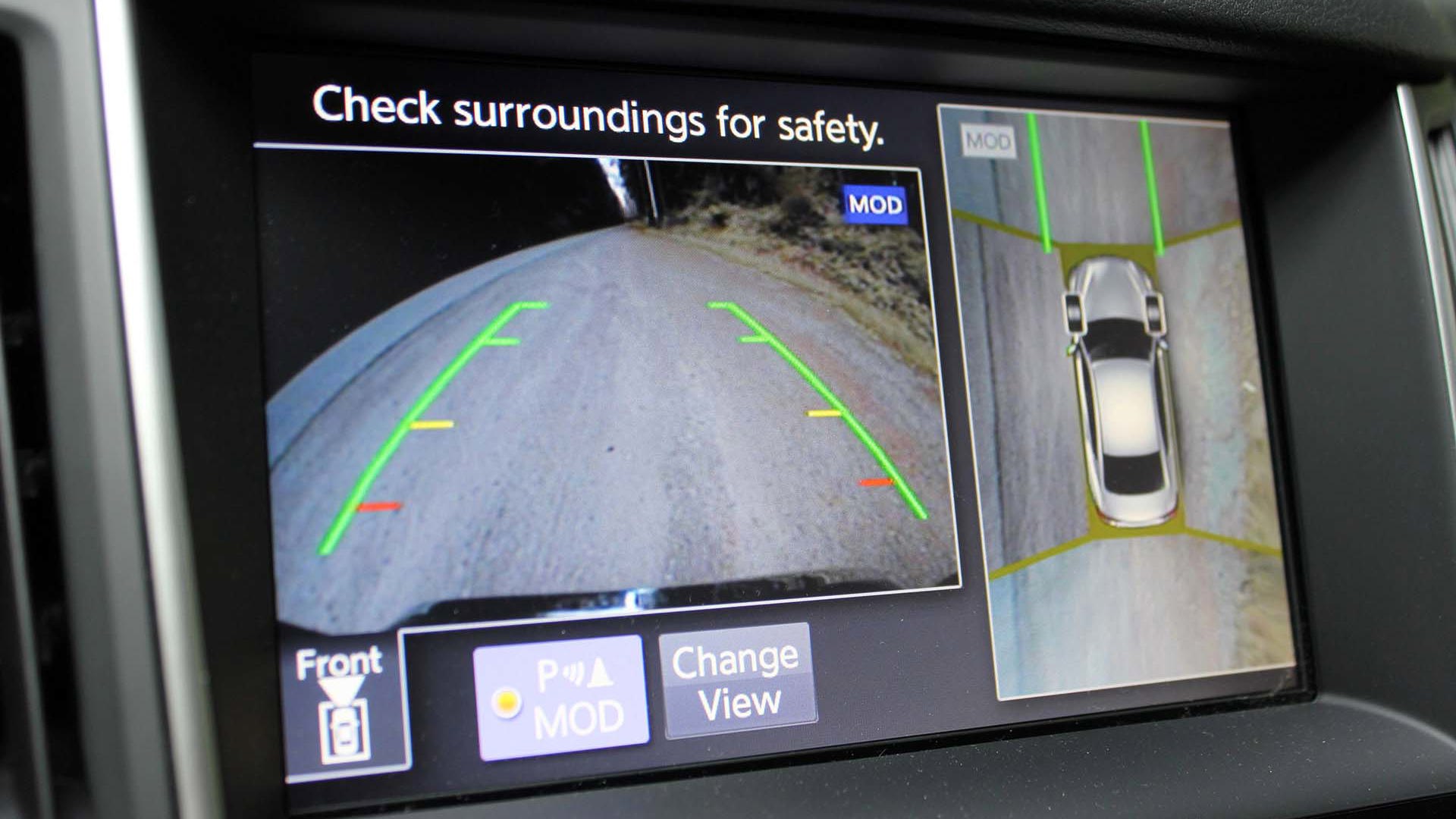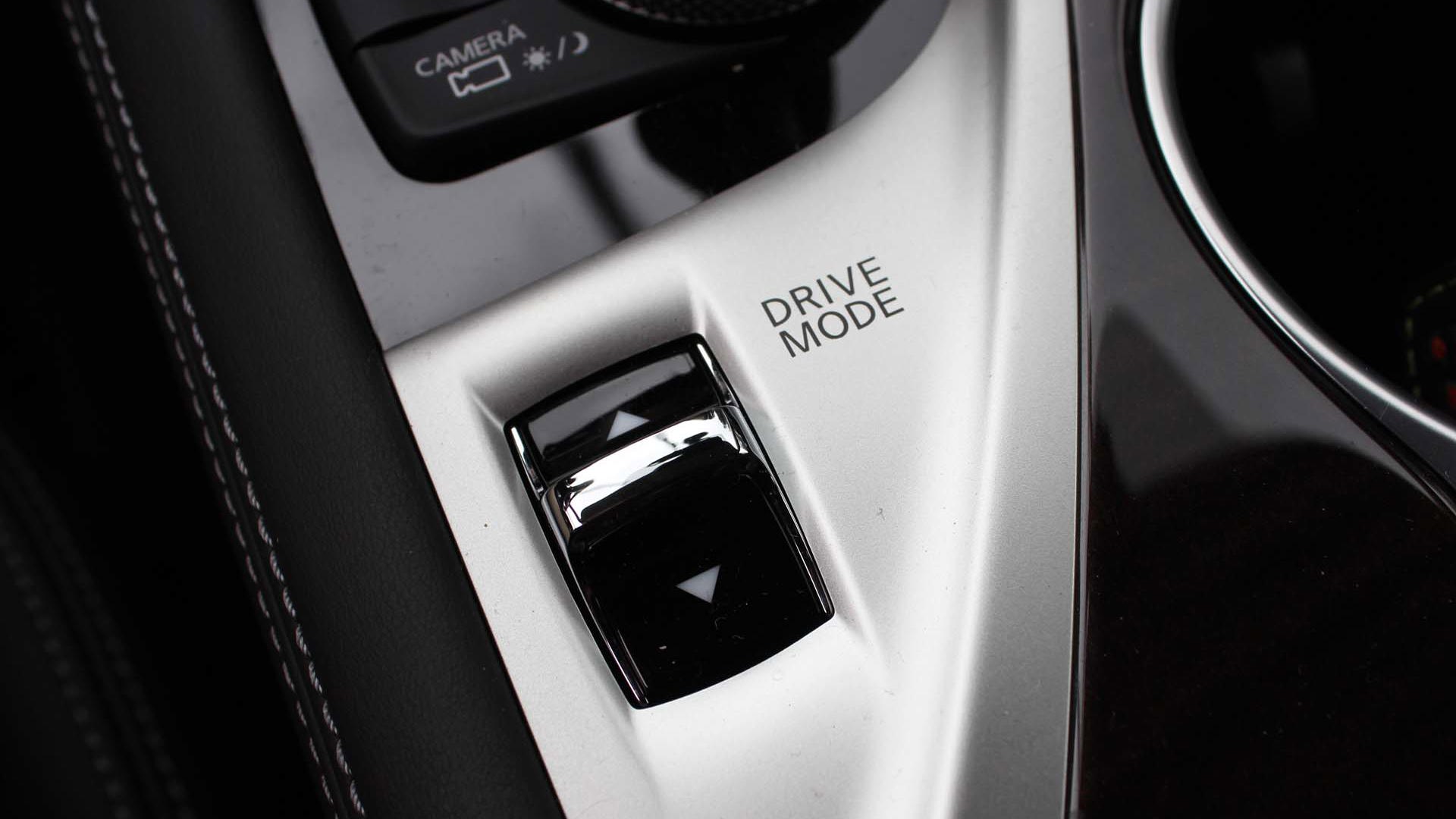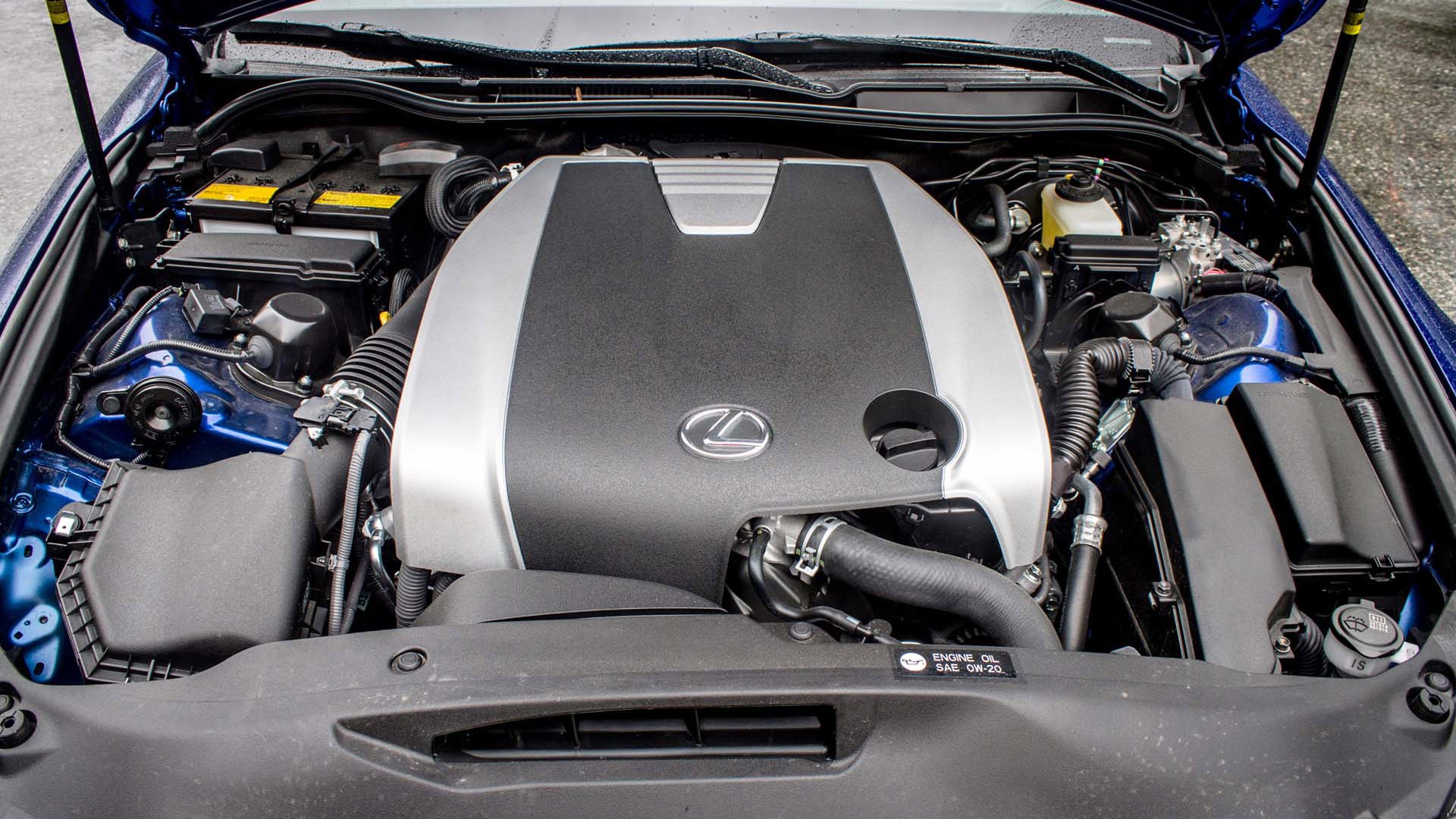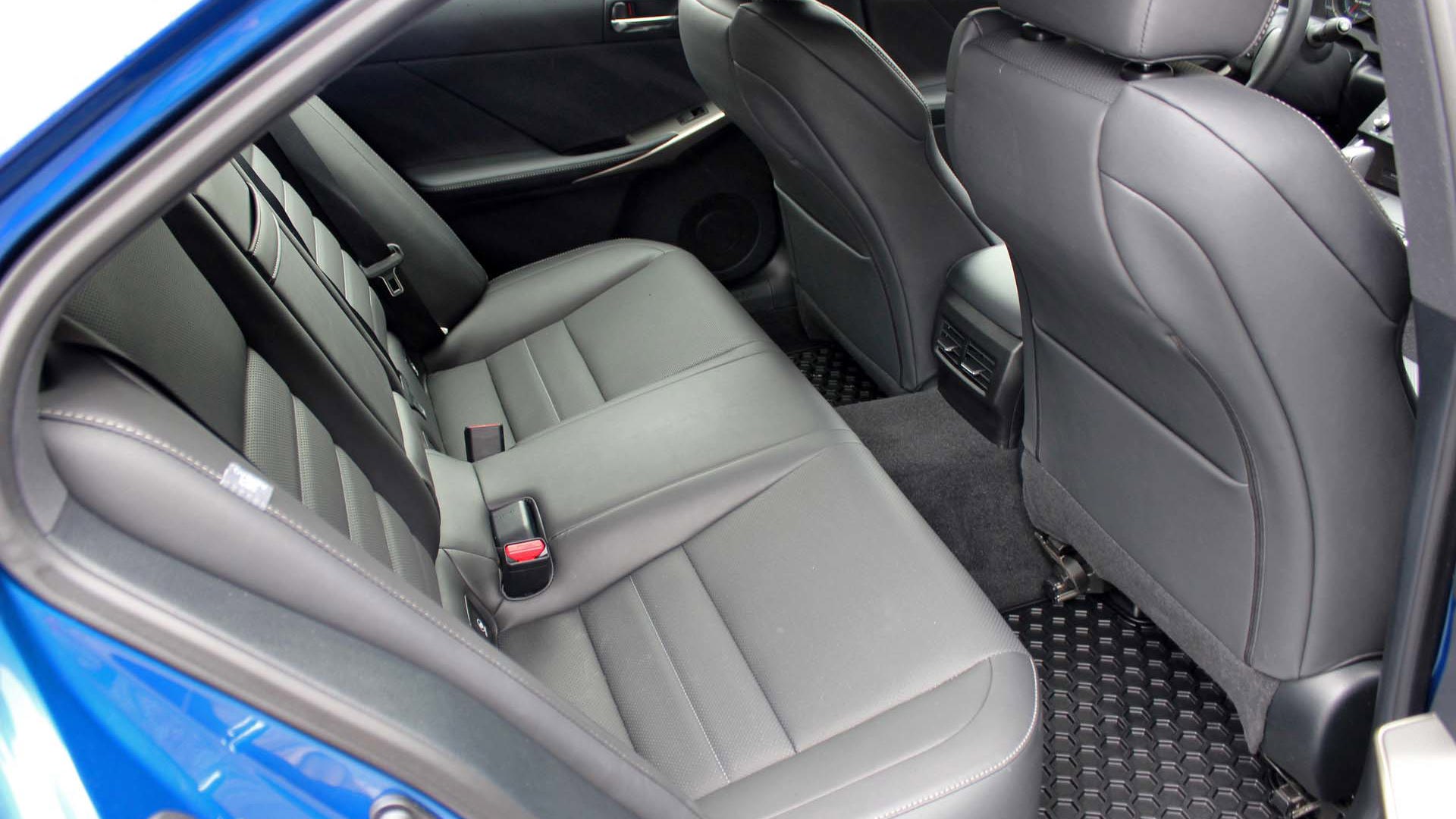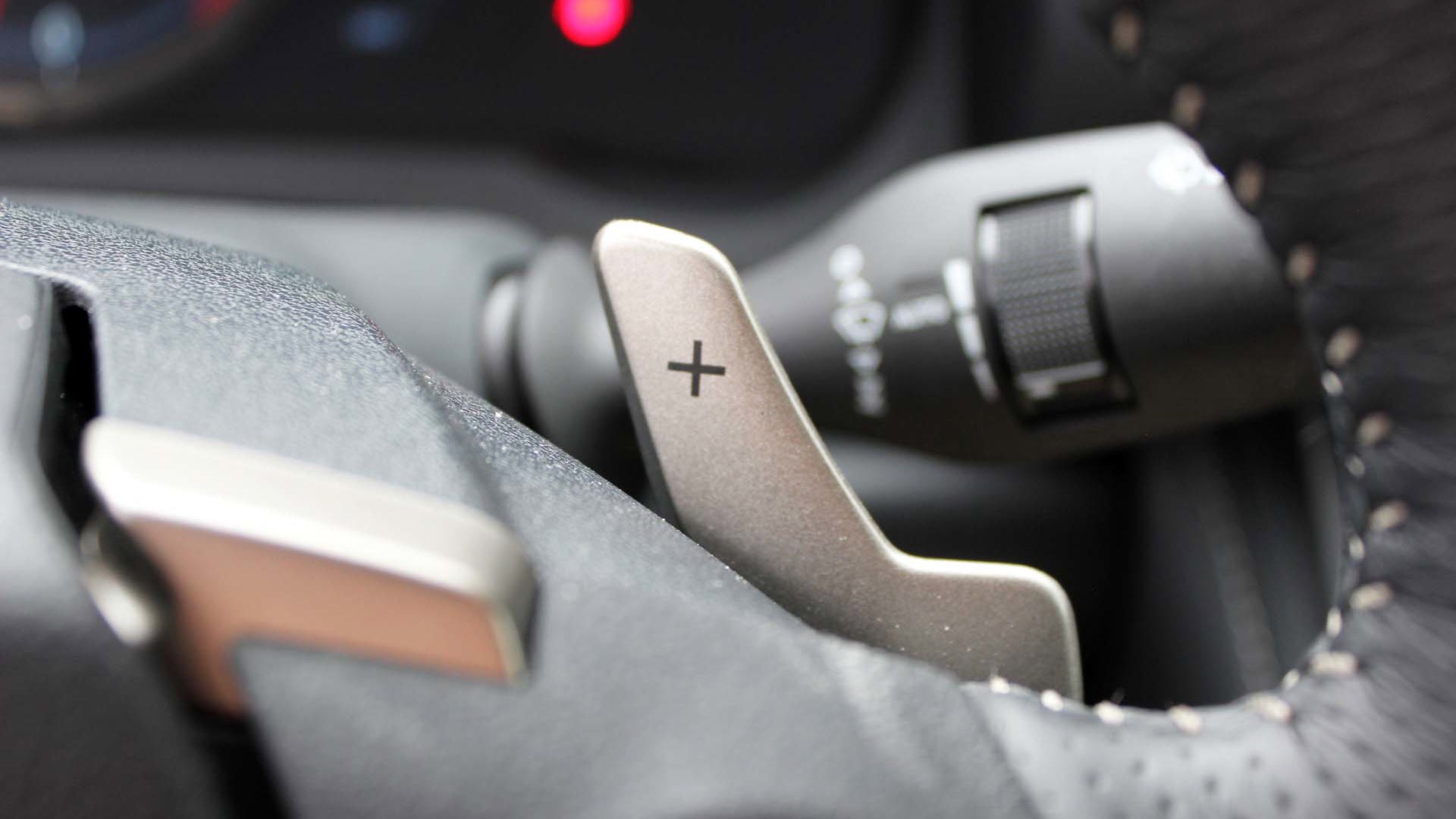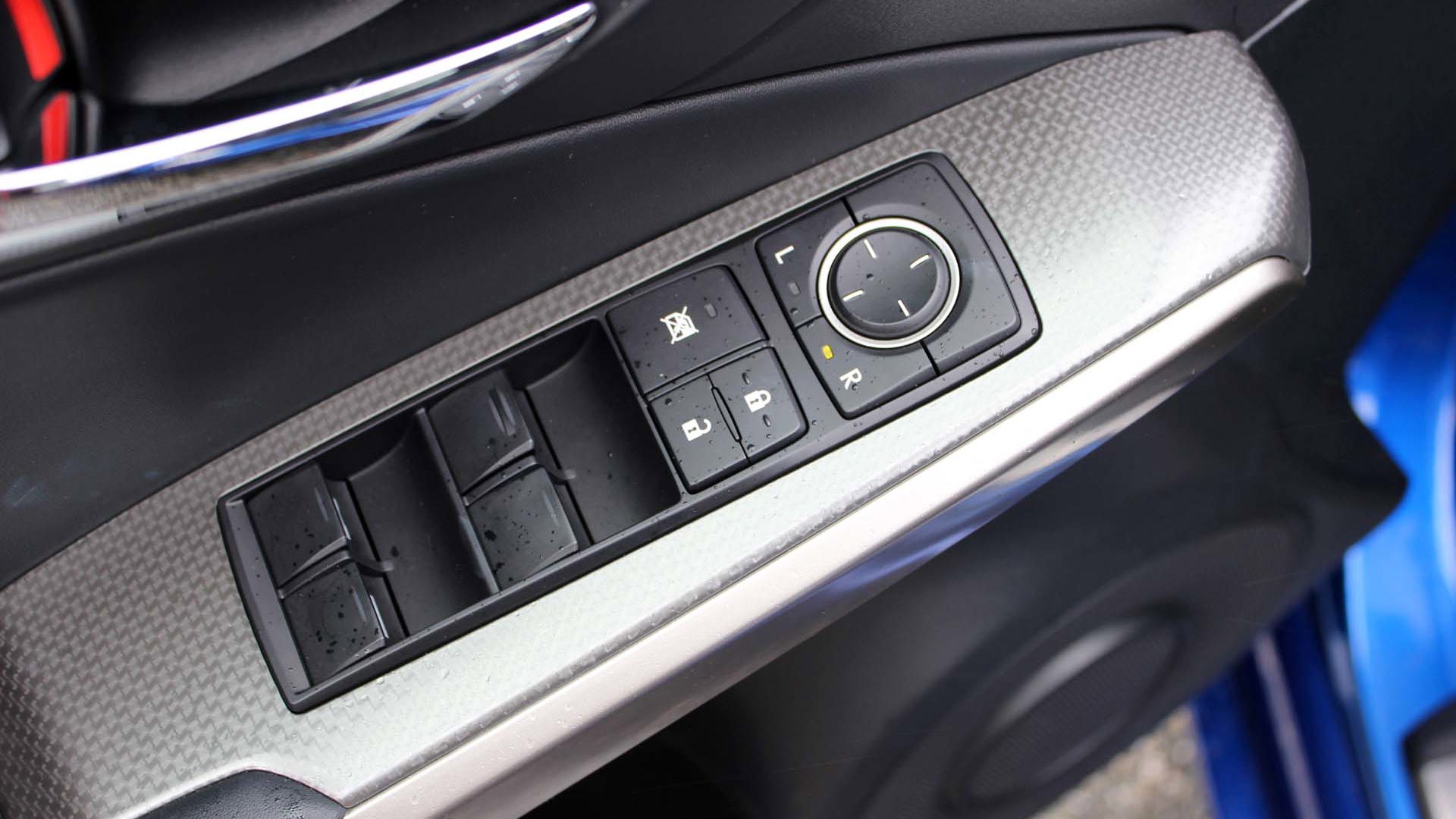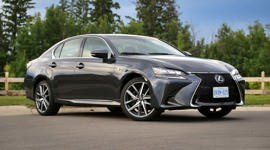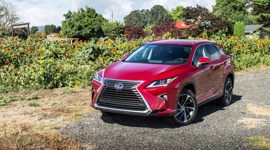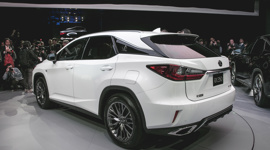Comparison Data
|
Base Price
$54,600
|
$51,900
|
|---|---|
|
A/C Tax
$100
|
$100
|
|
Destination Fee
$1,995
|
$2,045
|
|
Price as Tested
$60,780
|
$55,395
|
|
Optional Equipment
|
Dan says: I don’t know about you, but I like an underdog. With the exception of professional hockey, where I support a certain team fervently, I seem to always cheer for the dark horse in sports where I don’t really belong to any single fanbase. I liked Cleveland in last year’s NBA finals. Wanted more than anything for New England to bow in the Super Bowl two years ago. Get me to a horse race, and I would likely never win a bet.
After several years on the market, I think we can safely say that the Lexus spindle grille is beginning to look a little less crazy. No. Sorry. I mean the exact opposite of that.
So it’s with that in mind that I consider the two cars you see here. Both Japanese sedans, both all-wheel drive, both of the luxury bent and both powered by V6 engines but oh-so-separate when it comes to their place on the automotive landscape. The IS series is Lexus’ second-biggest seller after the sales behemoth that is the RX, while the Q50 continues to struggle in gaining the sales traction set by its G35/G37 predecessors.
But hold on a second! Small as its sales figures are, the Q50 is second in line at Infiniti after (big surprise) the QX60 crossover when it comes to sales, even though the IS outsells it by an almost 3:1 margin. The real question, then, is can the addition of the hi-po Red Line model (Infiniti’s answer to Cadillac’s Vsport range, BMW’s M Sport range and, of course, Lexus’ F Sport range) convert Lexus diehards, who have being buying F Sport models for years?
Styling
Brendan says: After several years on the market, I think we can safely say that the Lexus spindle grille is beginning to look a little less crazy. No. Sorry. I mean the exact opposite of that.
What an angular bunch of lunacy we've got here, a fractal mass of triangles and lines that look like the car was shattered, then glued back together. Next to the Q50, the Lexus looks like a mesh rendering of Edvard Munch's The Scream. Well, if your reason to buy one of these machines over a BMW 3 Series is to stand out a little, there you go. I like the wheels though.
By contrast, the Q50 is a much smoother, curvier presence. It's not exactly feminine, either, just more of a polished, cohesive shape. The little squiggle at the back of the greenhouse is a little too self-conscious, proclaiming, “We're not BMW, and this isn't a Hofmeister kink, no sir.”
The Infiniti speaks softly, but it carries a big stick.
Other than that, the Infiniti fades into the background on this rainy day, and the Lexus stands out. A luxury sedan is supposed to have presence, true, but I'd rather have a machine that wasn't so shouty about its intent. The Infiniti speaks softly, but it carries a big stick – more on that in a bit.
Interior and comfort
Dan says: Big differences here. The IS is a much snugger fit overall, especially for drivers and rear passengers. For some, this is the right idea; a performance-lite sedan like this should have you feeling ensconced in its environs, and the IS 350 is most definitely that from the perspective of the driver. You sit cocooned in the high-quality leather seat, with the wheel falling nicely into your hands and the rest of the interior controls not much more than half a reach away.
I have to say, though, that the Q50’s cockpit feels the more upscale of the two. From the magnesium and leather boomerang-shaped paddle shifters, to the subtle blue halos around the turbine effect gauges, to how it all feels fastened together tight like a drum, it’s a great place to be. While the Lexus’ seats are a little plusher, certain aspects let it down: the sometimes cheap-feeling buttons, for example (especially those that complement the infotainment system’s main controller), or the heavy dose of plastic on the centre stack. It’s not quite on the same level as the Q50.
The Infiniti is also roomier inside and that’s especially felt by the rear seat passengers, who have an additional 74 mm of legroom and 95 mm of shoulder room, while both cars are pretty much bang-on in the rear headroom department.
The numbers are one thing, but the Infiniti feels a whole lot airier inside than they suggest. Yes, the seats are a little flatter due to smaller side bolsters than those found in the Lexus, but it’s not as if we found ourselves sliding to and fro as we tackled one of our favorite bendy roads.
Plus, the front seats are of Nissan’s “Zero Gravity Seating” variety, meaning they have been developed in partnership with NASA to support bodies of all shapes and sizes in the right areas, in order to reduce fatigue on longer drives.
While the front seat isn’t quite as coddling as it is in the Lexus, I am a big fan of the low dash in the Q50. It provides a great view out, greatly reducing front-left and -right blind spots. Somehow, even though I’m 6’3”, I didn’t feel as though I was sitting on top of the car as opposed to inside it. It’s a neat trick that Infiniti’s managed to employ, and it should please drivers of all sizes.
The cargo situation is similar; the Infiniti beats the Lexus on this front by just over 75 litres, but the Lexus does provide a larger trunk opening and flatter load floor. The Q50’s lower profile rear seats, however, sit a little flatter than do the Lexus’ when folded. It’s just too bad about that narrow trunk opening, which does make loading larger objects a challenge.
Brendan says: As a parent, the IS's small back seats would pretty much be a deal-breaker for me. I'm glad I'm only average height, and I'm sorry we tried to cram you back there, Dan. Sorry. I hope your leg bones heal soon.
Those Lexus front seats though, are just wonderful. Basically, the IS feels like a sport sedan inside, and the Q50 feels like it's copying bits from the Mercedes E-Class. As is becoming a recurring theme in this test, I really need a couple of hours and a wrench to make one perfect car from the two.
Tech
Dan says: How you feel about the Lexus’ mouse-based interface is really going to kind of determine how you feel about the infotainment in general, because the controller mounted just behind the shifter pretty much controls everything in this department.
The way the on-screen cursor snaps to the nearest button takes a little getting used to, as it will often snap to a button that you weren’t quite expecting. It takes some patience, and we were happy to find a few supplementary buttons that take care of things like reverting to your home screen and so forth. Some will say it’s nice to not have to repeatedly spin a wheel to and fro to get to the menu you need, while others will find the mouse system counter-intuitive.
The Q50 doesn’t suffer from the same split personality, though it does have two screens. The upper screen displays your back-up camera and navigation (you navigate this with a scroll-wheel mounted behind the shifter), while the lower item lets you manage your drive modes (your steering weight and response, transmission settings and throttle settings are all modified from here), your driver aids, and even access your email or a select few apps. It’s incredibly technology-forward, and makes the Lexus’ item look almost prehistoric. The Lexus’ dated graphics don’t do a whole lot to help its cause.
However, while your eyes and fingers will appreciate what the Infiniti has to offer, your ears would likely opt for the Lexus. The sound through our tester’s eight-speaker premium audio system sounded crisper than what was being offered from the Q50, which is strange considering the latter’s 14-speaker system, which comes as standard on the Red Sport edition.
Comfort-wise, these two are pretty much in a dead, ahem, “heat”. Heated front seats, steering wheel, and dual-zone climate control are all on hand; I guess you could say the Lexus just barely pips the Infiniti in that its front seats are cooled, as well.
What the Q50 gives away there, though, it gains back on the driver aids front. For starters, you’ve got Infiniti/Nissan’s Around View monitor that provides a near 360-degree view of what’s going on around you at low speeds. I’m especially a fan of the camera sitting above the front-right wheel, that ensure you don’t come to close to the curb when parking, which could have you clipping one of those gorgeous rims in the process. Navigation, predictive forward collision warning and emergency braking also come as standard on the Red Sport – they’re optional on the Lexus – as does blind spot warning and rear cross-traffic alert. That’s just the standard stuff; our car’s $3,800 technology package upgrades the standard blind spot system (warning chimes, blinking lights) to an active one that will actually apply the brakes if you start to wander into another car’s path. In that same vein, an active lane departure system is also added. Add adaptive cruise control, and you’ve pretty much got an autonomous car that isn’t.
The Lexus? Well, it rings in at just over $5,000 less than the Infiniti (thanks in no small part to that tech package), but to get a similar amount of equipment from the Lexus, you have to add another two grand or so, and the tech you eventually do get isn’t quite as well implemented as the stuff in the Infiniti.
Brendan says: Far and away, the Infiniti is the tech champion here, to the point that they've introduced some stuff we didn't necessarily want (the drive-by-wire system). And yet for all that, I'd rather have the IS 350's stereo. Lexus is just so good at the audio thing.
Performance
Brendan says: Can I get the Infiniti's engine in the Lexus's chassis? No? Bah.
These cars look the same, but their approach to performance is completely different. The Lexus is the balanced approach, a sort of Japanese answer to BMW. Its 3.5L V6 produces 306 hp and 277 lb-ft of torque, respectable figures, but not oversauced ones – just a dash of wasabi, please, chef. Activate sport mode, stomp on the throttle, and off the IS shoots, hitting 100 km/h in just under six seconds or so. It sounds pretty good too. I wish Lexus would hurry up and give us the eight-speed automatic you get in the base car, and rear-drive (US) F-Sport models.
But the Q50 straight up stomps it. Infiniti's twin-turbocharged 3.0L V6 is a little bit of GT-R under the hood, making an even 400 hp, and an accessible 350 lb-ft of torque from just 1,600 rpm. There's nearly no comparison between the two, with the Q60 hitting highway speeds in a little over four seconds. The seven-speed transmission is quick too.
That's not just respectable, that's fast. Too bad the Q50 doesn't back up its straight-line dominance in the handling department.
Dan says: I would say that Mr. McAleer is holding back a little: the Q50 isn’t just fast, it is crazy fast to the point where you have to wonder if it’s almost over the top, and how can a car that cost this feel so freaking quick? Instant traction, plus that great seven-speed auto has you off the line and into the horizon lickety-split, a Nissan GT-R to the Lexus’ baby-ES attitude. It’s all-encompassing, and a nice surprise from Infiniti.
Of course, it’s not that the Lexus is bad; the exhaust note is a proper one, and it will still leave the line with gumption. Of course, it’s plenty fast for most applications, too, and I doubt many buyers will lament any lack of straight-line speed.
They won’t, that is, until they put it up against the Red Sport, at which point even first-time sports sedan buyers will have a hard time denying just how much faster the Infiniti feels. Yes, you gain a little of that back at the pump as the Lexus displayed slightly better fuel economy throughout our test than the Infiniti, but I would hardly call that a knockout punch on behalf of the Lexus.
Handling
Dan says: While the Infiniti with its 400 hp V6 is the star on the straight-line, hole-shot front, the competition for handling laurels is not quite so black and white.
Our Q50 came equipped with an adaptive steering system that either does the work on its own, or allows you to configure it separately (once you learn to navigate the nested menus required to get at it, that is).
It’s a steer-by-wire system, with electric actuators in the steering column telling the front wheels what to do once the driver’s inputs are received. It’s great in that it lowers response time; not so great in that it really robs the steering of the feel that’s provided by the Lexus. As a result, we found ourselves kind of guessing, a little, how much steering angle was required in turns.
The Lexus, on the other hand, felt the more direct rack; it’s an electronically assisted set-up, of course, but doesn’t feel it as much as the Infiniti did, which stands to reason. Indeed, I actually felt the steering on the Lexus was a little too heavy at slower speeds.
Our Q50 did come equipped with Infiniti’s Active Trace Control tech, however, which can be activated/deactivated from the same touchscreen interface. When active, it applies the brakes to whichever wheel requires it in order to bring the car back on-line. It helps reduce the steering connectivity issues, in a nicely subtle way that doesn’t feel like it’s wrenching the car from your hands.
Both vehicles come with some form of adaptive suspension, though the Q50 is the only one that lets you individually set the dampers. Not that the Lexus suffers too much for this; it’s actually quite good at reading the ground below you and responding in kind. It’s the better handling car, bar none.
Brendan says: It feels to me like the IS was developed on California's canyon roads and the Q50 on its highways. The latter is a point-and-shoot monster, while the former is more about building some momentum and having a little fun with it. If I got stuck behind a truck on the Sea-to-Sky, I'd much rather be in the Infiniti, which is also a bit more relaxing to drive. On the parts where the road turns twisty, I'd much rather have the Lexus' chassis and steering. The Q50's steering is just so numb.
Once again, can somebody pass me the welding torch and the socket set? There's a really good car here where these two overlap.
Dollars and sense
Brendan says: At $60,680, claiming value victory for the Infiniti is hard to do. The Lexus is also pretty expensive at $55,295, but both are considerable less than the German competition.
However, in this segment, owners are almost certainly going to be leasing their cars, and thus the Lexus's price advantage isn't as definitive. Further, if you wanted to have the same level of equipment in both cars, you'd need to check the box for the F-Sport Series 3 package at a price of $2,000. Suddenly, you're looking at adding $40 a month or so to your payment for an extra 100 hp. For a sport sedan, that's a strong argument.
If you're buying, however, I'd strongly recommend the Lexus here. Infiniti does reasonably well on resale values, but an all-wheel-drive Lexus product will simply outperform almost anything in the resale game short of a Toyota Tacoma. It looks crazy, but the IS is a nice, safe bet.
For operating costs, the Lexus is also cheaper to run than the Q50. Official fuel economy results for the Infiniti are 12.3 L/100 km in the city and 9.1 L/100 km on the highway; the IS 350 scores 12.6 L/100 km in-city and 9.2 L/100 km on the highway. Don't be fooled by the close scores: over the day of driving, we saw the Q50 burn about a litre more of gasoline per 100 km. Turbocharged engines get thirsty the more you dip into the boost, and you'll want to dip into the boost with the Q50.
Conclusion
Dan says: I’m not sure that the Lexus is the better car overall, however. For starters, the power made by the Infiniti is flat-out addictive; there’s really no other way to put it. A little while back, Infiniti teased the world with the Q50 Eau Rouge, essentially dropping a Q50 shape on the drivetrain of the Nissan GT-R supercar. It was never really destined for production, but the seed was nevertheless planted in the minds of someone who was hoping for a fast four-door that could actually take the fight to the Germans.
So we’re left with the Red Sport, and if I may, it’s not a bad option. Based on power alone, this particular Q50 is definitely a player; while turbocharged, the Red Sport doesn’t suffer from as much turbo lag, or drone along, forcing the engineers to pump an engine sound of sorts through the speakers as is done with some of its competition. It’s surprisingly granular feeling for something turbocharged, which I guess is what you’d expect from a brand that’s been known to pull off a turbo miracle or two in its time.
It is let down, though, by its handling. There’s no denying that the IS the more centred car here, which may be what many buyers are looking for.
I don’t think so, though. I think that great power, the available tech and the value presented by the Q50 Red Sport are definite feathers in its cap. It’s the one we’d have, but can the Lexus juggernaut be slowed? I suppose time will tell.
Brendan says: For me, these two cars are defined by how much they aren't a BMW 3 Series. That car, particularly the 340i with the sport package, is a tough all-rounder to beat. Both the Lexus and the Infiniti have to try hard to differentiate themselves.
The Lexus does so by adding a little spice to a reputation for reliability. It's interesting (maybe too interesting) to look at, fun to drive, and shouldn't ever let you down. It's a good pitch, and no wonder it sells well.
Infiniti, on the other hand, didn't really bother trying to beat Bimmer at the balanced sports sedan game, and basically turned their Q50 into a 400 hp muscle car. There's lots of value here, but I came away from this car basically feeling like I was driving a very nicely finished SRT Charger. Why buy one of these over a BMW? Because it'll blow the roundels off a 3 Series in a straight line. That's a pretty compelling argument, especially when supported by comfortable seats and a lengthy toy list.


















